
Do your students complete an animal research project? I want to share with you some ways I teach about research writing using a writing workshop approach.
Before doing so, here are some things to keep in mind:
- Almost ALL of the research, writing, and reading is done IN CLASS. We work as a class, students work with their partners, and also write and read independently. When students publish (the last stage of the writing process) their writing, they then have permission to take their first draft home.
- Students are ENCOURAGED to choose the same animal as another student. In fact, I recommend (strongly!) that they do! One of the biggest benefits to working with another student is that they can share books and sources of information.
- I use a writing workshop approach to teach animal research. This means that I begin with a whole-class mini-lesson, which are listed below. Students then break into partners, research clubs, or independently apply the skill/strategy that I taught in the whole-class mini-lesson. In conclusion, we come together as a class again and meet to conclude our objective/mini-lesson for the day.
- I also use the writing PROCESS to teach animal research. This means that students pre-write, write their first draft, revise, peer and self edit, and publish.
- Animal research projects are a wonderful way integrate science, reading, and writing in a meaningful, authentic way! Common core standards are addressed through each mini-lesson.
- Conclude the animal research unit by hosting a one of a kind Animal Extravaganza!! Celebrate the learning of your writers, researchers, and animal experts by going all out with this party!
Ok, now let’s get started!
One of the first mini-lessons I taught was about choosing a “just right” animal to research. A just right animal is an animal that you are interested in learning more about but you don’t really know too much about them already. I explicitly modeled my thinking aloud, demonstrating how a dolphin would be a “just right” animal for me to research. I love dolphins, swam with dolphins in Florida, but do not know a lot about dolphins.
Students then met with a partner to brainstorm a list of animals they might be interested in. They filled out a graphic organizer to help them think about how much prior knowledge they already had about that particular animal. Some students choose to work together and research the same animal.
That night, students were encouraged to take a trip to their local library and check out any and all informational text books about their animal.
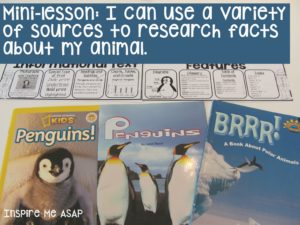
My next writing workshop mini-lesson was about using a variety of different sources to find facts about the animals. Again, I explicitly demonstrated the process of using a variety of different sources.
As I demonstrated each source, students kept track of each source on their graphic organizer. (Students are expected to use at least three different sources in their first draft.)
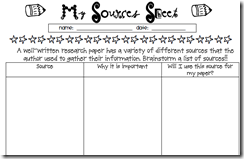
I gathered ALL the animal sources I could get my hands on- encyclopedias, magazines, informational text, DVD’s, internet sources, just to name a few!

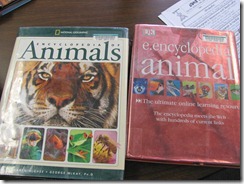
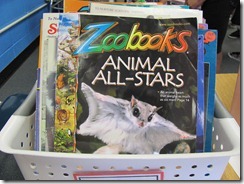

This is also the PERFECT unit to tie in informational text features!!!
I made it a point to be very clear when I talked about using the table of contents and index to quickly determine if the source had information I needed.
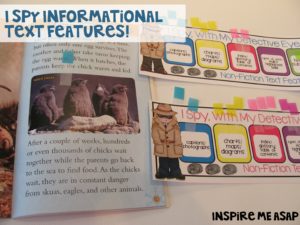
Students are then ready to meet with their partner or group and search through their own sources! Students work together to make sure they have at least three different types of sources.
In the following weeks, I teach several other writing mini-lessons. Some of these include the following:
*I can use a variety of different sources to gather facts about my animal.
*I can accurately quote the text from an informational text, using quotation marks and the page number.
*I can determine the most important ideas about my animal.
*I can collect and organize the facts into different categories.
You will notice that all of the mini-lessons are written as “I can” statements. I also refer to these mini-lessons as our objective, or learning target for the day. These are posted on our white board. At the end of every day, students write these down in their assignment notebooks. This way, parents see the learning targets and what we worked on in each and every subject.
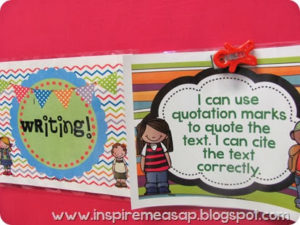
As I teach the mini-lessons, it is important to understand that every student is at a different stage of the writing process. Some students are still gathering facts and writing their first draft. Other students may be revising their first draft by adding additional information to one of the categories. Some students are finishing up the first draft and are ready to tackle peer and self editing.
Although my students already understand the writing process, I still teach specific mini-lessons about using editing checklists, for example. These are specific to the research writing genre.
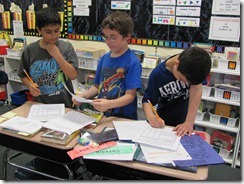
In the picture above, students are their own paper with a red pen so I could see the corrections they made to their first draft.
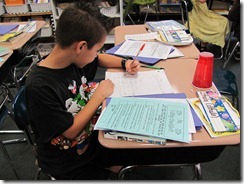
When the students finished their first draft and self-edited their paper,then they PEER edit.
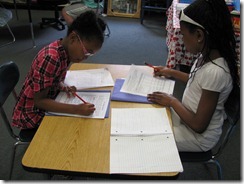

The animal expert reads their paper aloud and their peer listens and fills out the editing checklist.
After all those steps, students are finally ready to sign up for a conference with the teacher!

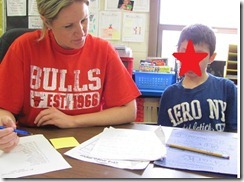
Depending on the needs of your students, you may spend 2-5 minutes working with each child. Writing conferences are a fantastic way to differentiate instruction for each child. It also holds them accountable for their personal best.
Finally, they are ready to publish! It is only at this stage of the project that I let them bring home everything so they can finish and come up with a creative way to publish their writing. One of the mini-lessons that I teach is about CREATIVE ways to publish their research paper.
Once I see that a majority of the students are done with their first draft, editing, revising, and conferencing with me, I then set a “due date.”
The due date is actually the date of our…drum roll please…
Animal Expert Extravaganza!
The pictures below are guaranteed to give you some ideas about how to host a wonderful writing celebrate for your new animal experts!!!
Spending a few bucks at Walmart will make a memorable learning experience for your students! Here’s what I had set up when the experts walked in:
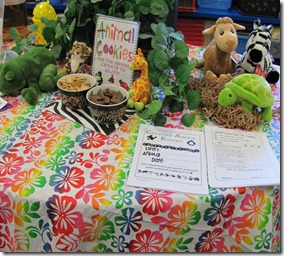

Stuffed animals and animal print galore, along with a jungle themed tablecloth.
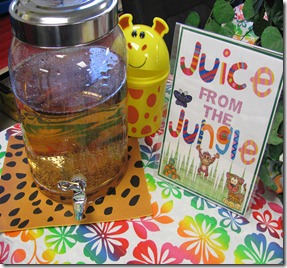


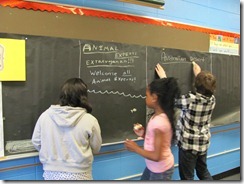
Before the experts began their presentations, these students used colored chalk to make a background on the black butcher paper. Students then signed up in the order they would present.
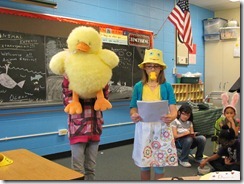

Animal Experts began their presentations with props galore!
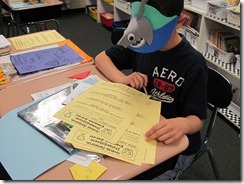

See those yellow sheets of paper? As the students were giving their presentations (each expert was given a 2 minute time limit), the audience members were filling out comment cards! This was a great way to keep the audience engaged and accountable during all the presentations. Each audience member was assigned to fill out a comment card for about 4 animal experts.
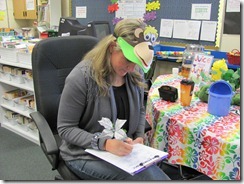 The teacher stays busy too during the animal expert presentations!
The teacher stays busy too during the animal expert presentations!
Here is a look at the finished projects:
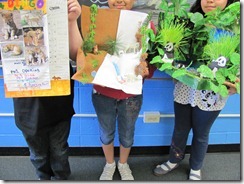
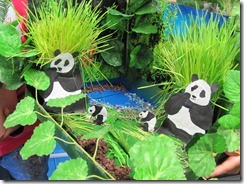

Talk about some creative ways to publish! No typed reports or poster board projects here!
When you hear your students say, “I didn’t know research could be so much fun” and “I like finding facts about my animal” and “This is so cool!” when they walk into the classroom on the day of the Extravaganza…you know you did something right!
The ideas presented in this blog post can be found in my Animal Research resource.
File Description:
There are 14 different mini-lessons that engage your students in using the writing process to use research skills to write a non-fiction report about an animal of their choice.
* Unique and creative ways to engage your students in a traditionally “boring” writing genre
*Creative way to celebrate and publish papers: Animal expert extravaganza (which will knock the socks off of your administration!)
*Colorful, student friendly anchor charts that clearly state the mini lesson and learning target
*A cooperative group learning project, which motivates and teaches your animal experts how to complete their own paper independently
*A bulletin board idea for how to display the writing process and the status of the class
*Student worksheets and resources which correlate directly with the 14 mini lessons and learning targets
Click HERE to purchase Animal Research through Teachers Pay Teachers.
Save 10% by purchasing Animal Research directly from my website.

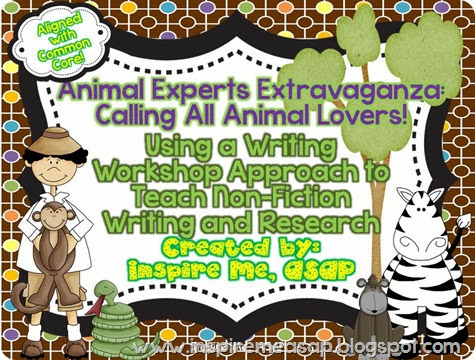





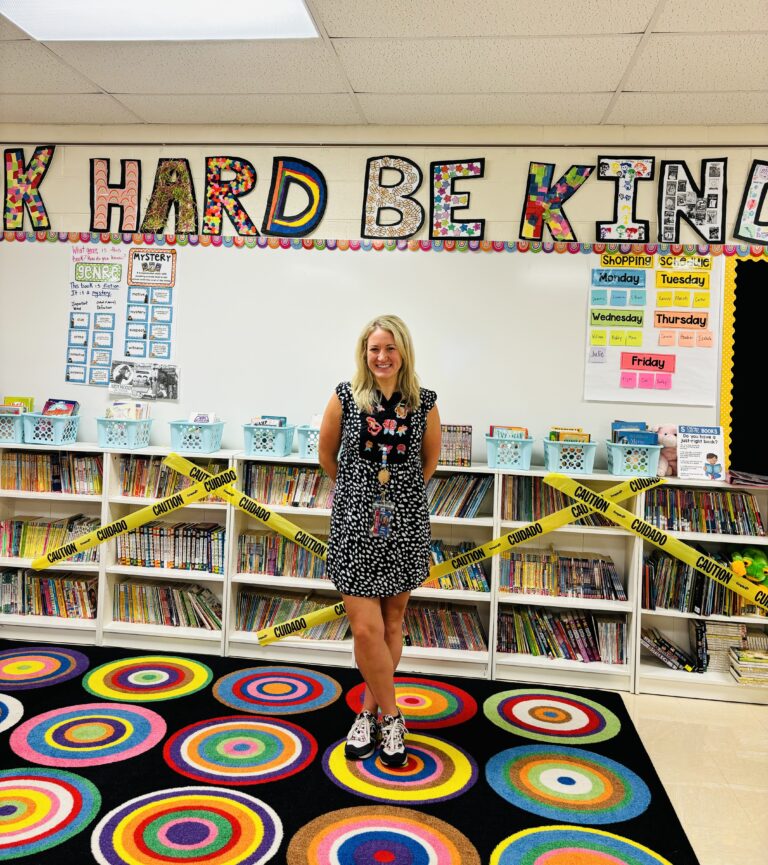



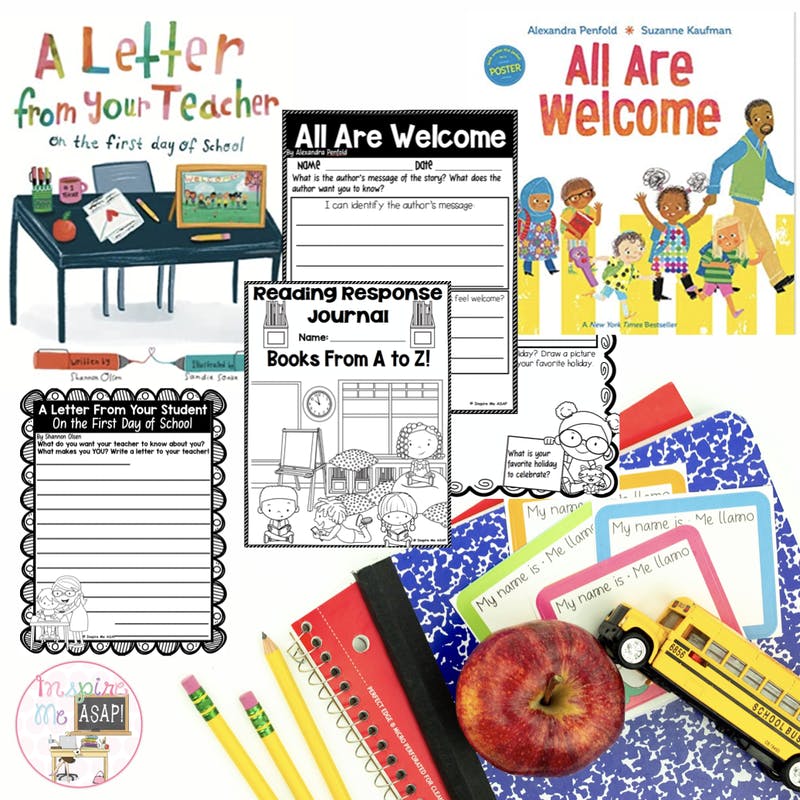
6 Responses
I bought this during the TpT sale! I'm so glad I did. My kiddos have learned TONS about researching and publishing! (oh yea…and about animals) This was a blast! I can't wait to add the party aspect to next year's lesson/celebration! Thanks so much!
Amanda
Third Grade Experience
I bought this from TPT. It was too late in the year to use it, but I am excited to use it next year. :) I appreciate that you blogged where you bought the gingerale etc. I love knowing exactly where to go, and not driving around to 5 stores to look for the best deal!! Thank you!!
LOVE this! You all are the BEST!
Great! We made "expert posters" this year for animal research. Each student had to incorporate 4 nonfiction text features into the poster and my 2nd grade kiddos ate up some Gail Gibbons! Can't wait to add to my unit using your ideas next year!
Rachel
Good Article About Not Your Average Animal Research Paper!
Term Papers
cool research and coool blog!
Custom Term Paper